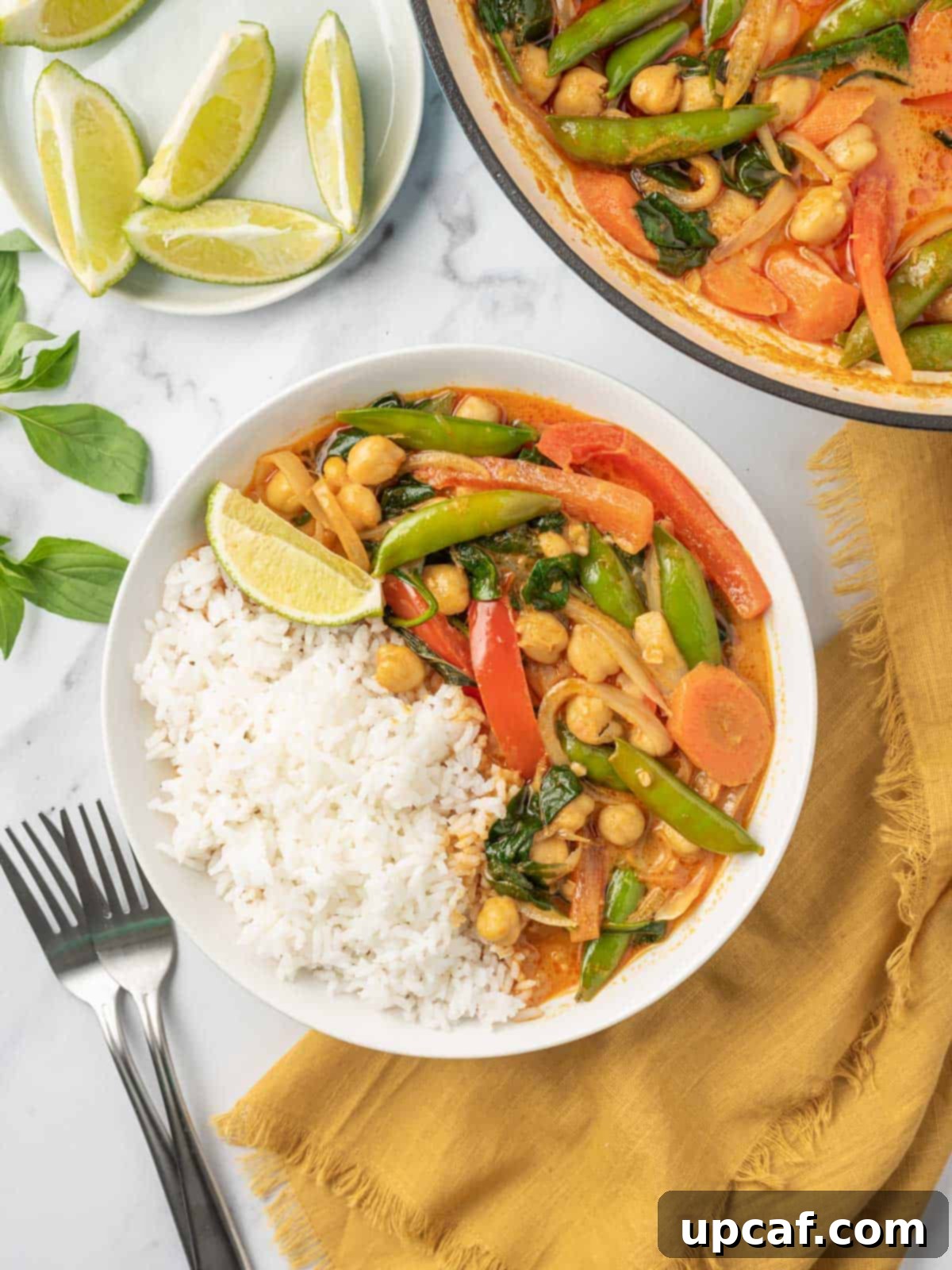Embark on a culinary journey with this incredibly flavorful and comforting Red Thai Vegan Curry, a dish that captures the authentic essence of Thai cuisine while being entirely plant-based. This recipe is designed to bring the rich, aromatic experience of traditional Thai red curry right to your kitchen, offering a vibrant medley of vegetables bathed in a luxurious, moderately spicy coconut sauce. Perfect for a quick weeknight dinner or a delightful weekend feast, this vegan delight can be on your table in just 35 minutes, customizable with your favorite seasonal vegetables and served over a bed of fluffy rice or silky noodles. It’s not just a meal; it’s an experience that promises warmth, satisfaction, and an explosion of bold Thai flavors that everyone, regardless of dietary preference, will undeniably enjoy.

This vegan red curry distinguishes itself with its bright, deeply flavorful, and utterly irresistible sauce. The perfect balance of moderate spice and creamy coconut milk creates a bold profile that tantalizes the taste buds. Whether you’re looking for a hearty lunch or a satisfying dinner, this recipe delivers on all fronts. Its simplicity also makes it an ideal candidate for meal preparation; you can easily double the batch and store portions for quick, healthy meals throughout the week. Having the ingredients for this Thai red curry with vegetables on hand means you’re always just minutes away from a wholesome, delicious, and authentic Thai meal. It’s a testament to how accessible and rewarding plant-based cooking can be. Experience the ease and delight of homemade vegan red curry, a dish that truly nourishes the body and soul.
If you’re a fan of the diverse world of curries and enjoy exploring various flavors, you might also appreciate other variations from our collection. For those who enjoy a different protein, consider trying our Thai Red Curry Chicken recipe for another burst of authentic Thai flavors that are equally satisfying and rich.
Why This Authentic Thai Red Curry Will Become Your New Favorite
Discover the many compelling reasons why this Red Thai Vegan Curry isn’t just another recipe, but a delightful and indispensable addition to your culinary repertoire. It seamlessly combines convenience with an explosion of rich flavors, making it a truly exceptional dish that stands out.
- Unforgettable Bold Flavor Profile: This vegan red curry is a symphony of vibrant tastes that will captivate your palate. It’s wonderfully spicy, deeply infused with rich coconut creaminess, and profoundly delicious. The careful blend of aromatic spices and herbs found in a quality red curry paste, combined with the subtle sweetness and richness of coconut milk, creates a complex and harmonious flavor that will transport your senses straight to the bustling streets of Thailand. Every spoonful offers a perfect balance of heat, luxurious creaminess, umami, and fresh herbaceous notes, making it a gourmet experience crafted right in your own kitchen.
- Remarkably Quick and Easy to Prepare: In today’s fast-paced world, finding time for wholesome, homemade meals can often feel like a significant challenge. While the allure of takeout offers undeniable convenience, preparing this authentic Thai red curry at home is surprisingly simple, far more rewarding, and often healthier. From the initial chop to the final garnish, you’ll need only about 35 minutes to create a dish that tastes like it emerged from your favorite Thai restaurant. This rapid preparation time makes it an ideal option for even the busiest weeknights when you crave something special and flavorful without dedicating hours to cooking.
- Perfect for Efficient Meal Prepping: Planning your meals in advance is a cornerstone of maintaining a healthy diet and managing a busy schedule effectively. This Thai curry with vegetables excels as a meal prep superstar. You can easily whip up a large batch early in the week, allowing you to enjoy delicious, convenient, and healthy lunches or dinners throughout the subsequent days. An added bonus is that the flavors of curry actually deepen and meld beautifully overnight, often tasting even better the next day as the ingredients have more time to infuse. For even greater convenience and future planning, consider making a double batch and freezing the extra portions. This foresight ensures you’ll always have a ready-to-eat, wholesome, and incredibly flavorful meal on hand for those days when cooking from scratch is simply not feasible.
- Incredibly Versatile and Customizable: One of the most appealing aspects of this Red Thai Vegan Curry is its impressive adaptability. The robust sauce serves as an excellent, forgiving base for almost any fresh vegetables you have available or prefer. Don’t have snow peas? No problem! Try incorporating green beans, broccoli florets, or even chopped zucchini. Desire more plant-based protein? Easily add pan-fried tofu, tempeh, or edamame. This inherent flexibility ensures that the recipe can always be fresh and exciting, allowing you to cater to your specific tastes, utilize seasonal produce, and make the most of whatever ingredients are readily accessible in your pantry, minimizing waste and maximizing enjoyment.
- A Wholesome and Healthy Plant-Based Option: For those who actively follow a vegan lifestyle, are looking to transition to more plant-based meals, or simply wish to incorporate healthier options into their routine, this curry is a fantastic choice. It is generously packed with nutrient-dense vegetables, offering a rich array of vitamins, minerals, and dietary fiber. It also utilizes healthy fats derived from coconut oil and full-fat coconut milk, which are beneficial for sustained energy and satiety. By consciously selecting fresh, vibrant ingredients, you are not only crafting a meal that is exquisitely delicious but also one that contributes significantly to your daily nutritional intake, thereby supporting your overall health and well-being in a delectable way.
- Dietary Inclusivity for Everyone: This Red Thai Vegan Curry is naturally free of common allergens like dairy and meat, making it an excellent choice when cooking for a diverse group of diners. With careful selection of gluten-free curry paste and serving it with rice or gluten-free noodles, it can also cater to gluten sensitivities. This dish ensures that everyone at your table can enjoy a truly satisfying and flavorful meal together, fostering a sense of community and shared culinary delight.
Essential Ingredients for Your Delicious Vegan Red Curry
Crafting the perfect Red Thai Vegan Curry begins with selecting high-quality, fresh ingredients. Each component plays a crucial role in building the dish’s signature bold flavor profile, creamy texture, and vibrant appearance. Here’s a detailed look at what you’ll need to create this exceptional plant-based meal:
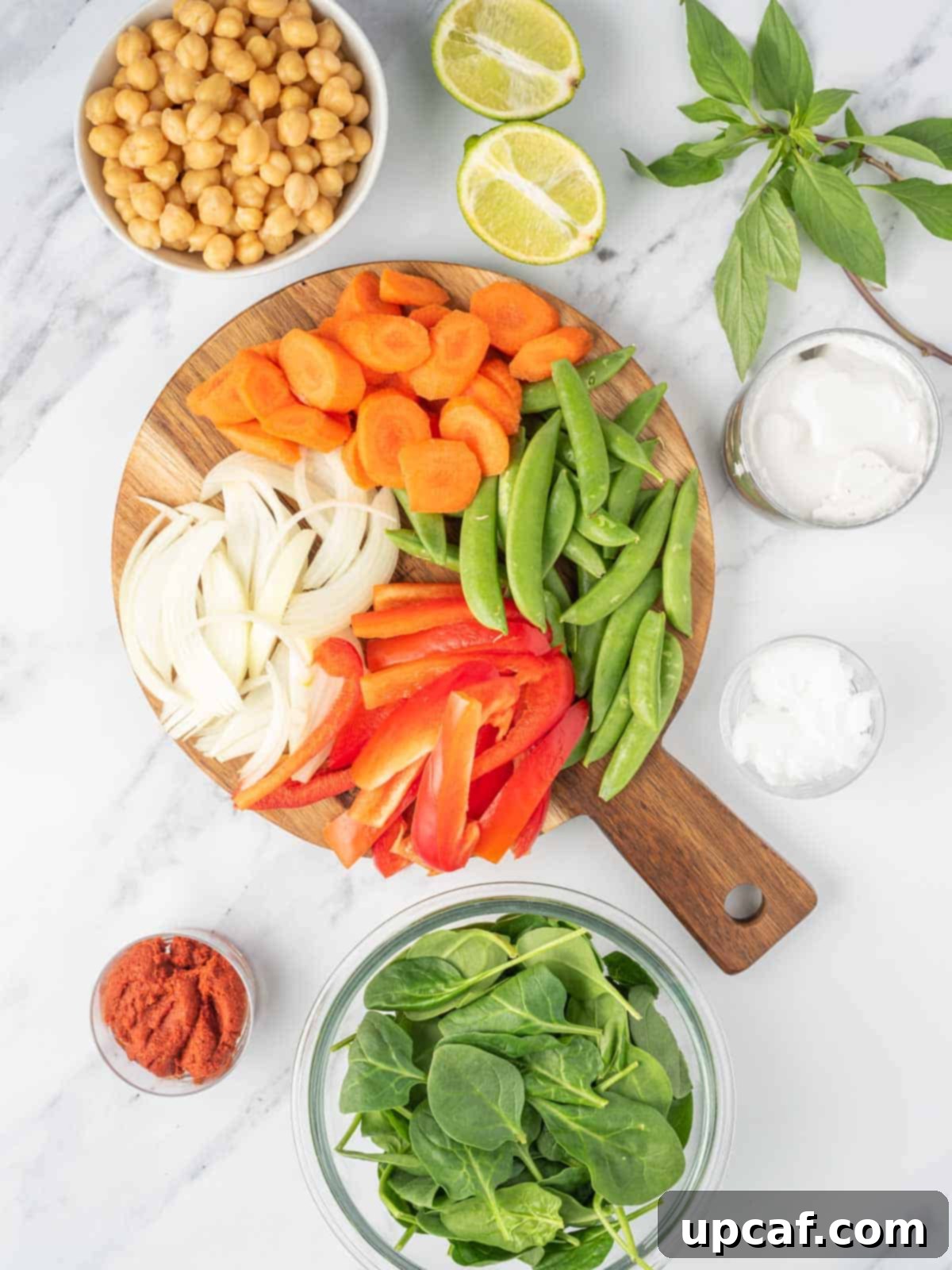
- Coconut Oil: This tropical oil is essential for sautéing our aromatics and initial vegetables. Beyond its high smoke point, coconut oil imparts a subtle, complementary tropical flavor that beautifully enhances the overall taste of the curry. For those who prefer alternatives, another high-heat-friendly oil such as avocado oil or refined sunflower oil can be used effectively.
- Aromatics: These ingredients form the fragrant foundation of the curry.
- Garlic: Freshly minced garlic provides a fundamental layer of savory depth and pungent aroma that is indispensable in many Asian cuisines.
- Ginger: Freshly grated ginger adds a warm, spicy, and distinctly zesty kick. Its pungent notes are crucial for achieving that authentic Thai flavor profile that truly awakens the senses.
- Yellow Onion: Thinly sliced yellow onion creates a sweet and savory base as it slowly caramelizes during the sautéing process, significantly enhancing the overall aroma and underlying taste of the finished dish.
- Vibrant Vegetables: The appeal of this Red Thai Vegan Curry lies not only in its sauce but also in its fresh, filling, and colorful vegetable medley.
- Red Bell Pepper: Thinly sliced red bell pepper contributes a delightful sweet crunch and a beautiful, vibrant pop of color that makes the dish visually appealing.
- Carrots: Thickly sliced carrots provide natural sweetness and a hearty, satisfying texture that stands up well to simmering in the curry sauce.
- Chickpeas: Canned chickpeas (garbanzo beans) are an excellent addition, offering a wonderful source of plant-based protein and dietary fiber. They absorb the curry flavors beautifully, making the dish more substantial and incredibly satisfying.
- Snow Peas: Fresh snow peas introduce a delicate, sweet flavor and a delightful crisp-tender texture, providing a refreshing contrast to the richness of the curry sauce.
- Spinach: Fresh spinach wilts effortlessly into the hot curry, adding a significant boost of essential nutrients and a lovely, vibrant green hue, effectively rounding out the vegetable component with minimal effort.
- Red Curry Paste: This highly concentrated paste is truly the heart and soul of our Thai curry, providing its distinctive, complex flavor and characteristic heat. It is typically available in convenient jars in the Asian section of most well-stocked grocery stores. Red curry paste is a sophisticated blend, usually containing dried red chilies, aromatic lemongrass, pungent galangal, zesty kaffir lime zest, garlic, shallots, and various other spices. It’s important to remember that curry paste is distinctly different from curry powder, offering a far richer and more complex flavor profile. For a truly vegan dish, always carefully check the label to ensure it is free of shrimp paste (kapi) or fish sauce, as these are common traditional ingredients. Many excellent vegan-friendly brands are now widely available.
- Coconut Milk: The creamy foundation of this entire curry dish. We highly recommend using full-fat canned coconut milk for the richest, most luxurious texture, and the deepest, most authentic flavor. The fat content contributes significantly to the velvety mouthfeel and robust taste. If you prefer a lighter version, light canned coconut milk can be substituted, though it will result in a slightly less creamy consistency and a milder flavor.
- Salt: Essential for proper seasoning, salt plays a critical role in balancing and enhancing all the intricate flavors within the curry, ensuring each ingredient shines through. Always season to taste, adjusting as needed.
- Limes: Fresh lime juice is paramount for adding a bright, tangy, and invigorating finish that beautifully cuts through the richness of the coconut milk and awakens all the other flavors in the dish. Freshly squeezed lime juice offers a far superior, more vibrant taste compared to bottled varieties. Furthermore, lime wedges make an excellent garnish, both for visual appeal and for providing an optional extra squeeze of refreshing tartness at the table.
- Thai Basil: This aromatic herb provides a unique, slightly peppery, and distinctive anise-like flavor that is a hallmark of authentic Thai cuisine. Thai basil leaves are generally sturdier and possess a more intense, complex flavor than common sweet basil varieties. If authentic Thai basil isn’t readily available in your area, regular sweet basil can serve as a suitable substitute, though it’s worth noting that the flavor profile will be slightly different. It is primarily used as a fresh garnish to add a final burst of fragrant freshness and an authentic aromatic finish just before serving.
Crafting Your Red Thai Vegan Curry: A Step-by-Step Guide to Perfection
Making this incredibly flavorful and vibrant vegan curry is a straightforward process that yields truly impressive, restaurant-quality results in your own home. Follow these simple yet crucial steps to create a delightful and satisfying meal in minimal time.
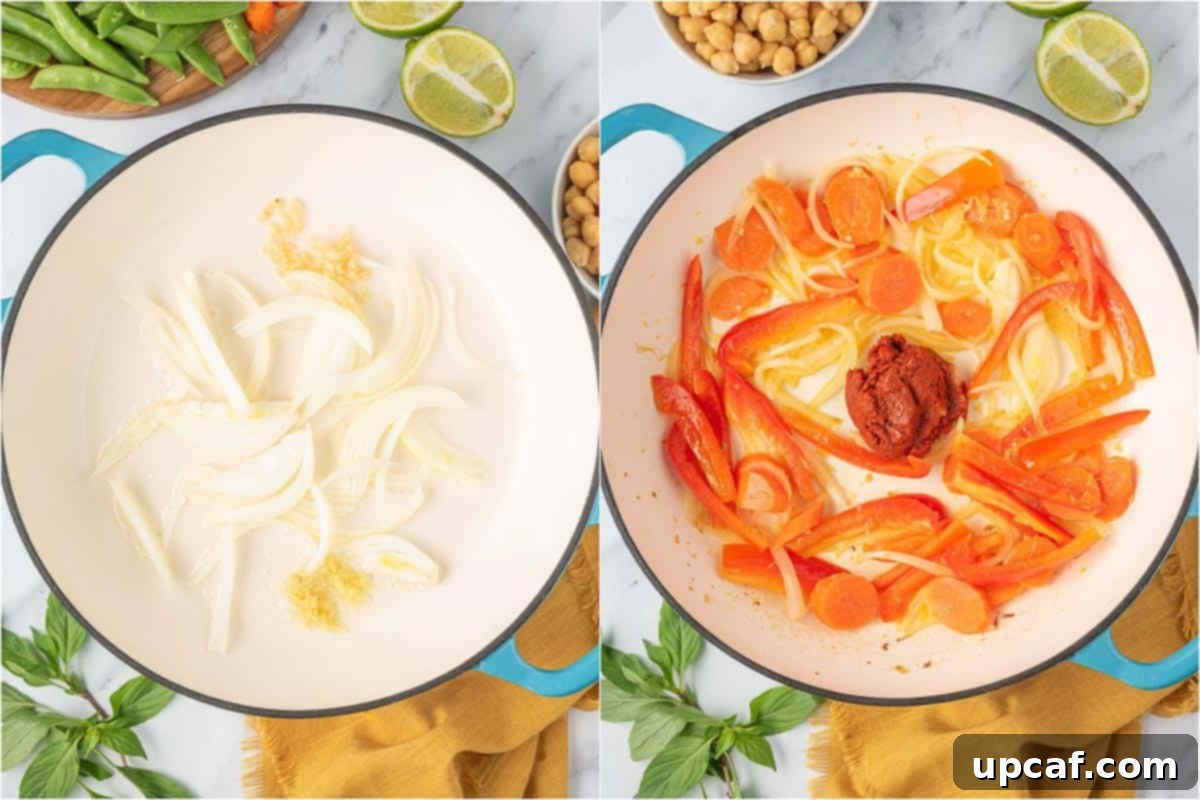
- Step 1: Sauté the Aromatics and Initial Vegetables. Begin your culinary adventure by heating two tablespoons of coconut oil in a large skillet or a sturdy Dutch oven over a steady medium heat. Once the oil is shimmering gently, add the finely minced garlic, freshly grated ginger, and thinly sliced yellow onion to the hot pan. Sauté these fragrant aromatics for approximately 2-3 minutes, stirring continuously, until they become wonderfully fragrant and the onion softens and turns translucent. This initial step is absolutely crucial for building the foundational depth of flavor for your entire curry. Next, introduce the thinly sliced red bell peppers and the robust, thickly sliced carrots to the skillet. Continue to sauté for an additional 3-4 minutes, allowing these vegetables to soften slightly but still retain a pleasant, desirable crispness. Finally, stir in the red curry paste, ensuring it’s evenly distributed. Cook the paste for about one minute while stirring constantly; this critical step allows the concentrated flavors of the paste to “bloom” in the hot oil, releasing its full aromatic potential and significantly deepening its rich flavor.

- Step 2: Develop the Creamy Sauce and Incorporate Remaining Vegetables. With the aromatics and initial vegetables fragrant and tender-crisp, it’s time to build the luscious sauce. Carefully pour in the full-fat canned coconut milk and add the specified amount of salt to the skillet. Stir everything together thoroughly until the red curry paste is completely dissolved and perfectly combined with the coconut milk, forming a smooth, vibrant sauce. Bring this mixture to a gentle boil, then immediately reduce the heat to a steady medium. Now, add the canned chickpeas (which should be rinsed and drained) and the fresh snow peas to the simmering curry. Allow the curry to simmer gently for approximately 5-6 minutes. This simmering time is essential as it allows all the beautiful flavors to meld together harmoniously and ensures that the chickpeas are heated through, and the snow peas are cooked to a perfectly tender-crisp texture, retaining their freshness. Finally, add the fresh spinach to the simmering curry. Stir it in gently and allow it to cook for just 2 more minutes, or until the spinach has fully wilted and integrated into the sauce. Be careful not to overcook the spinach, as this helps to maintain its vibrant green color and maximize its nutritional value.
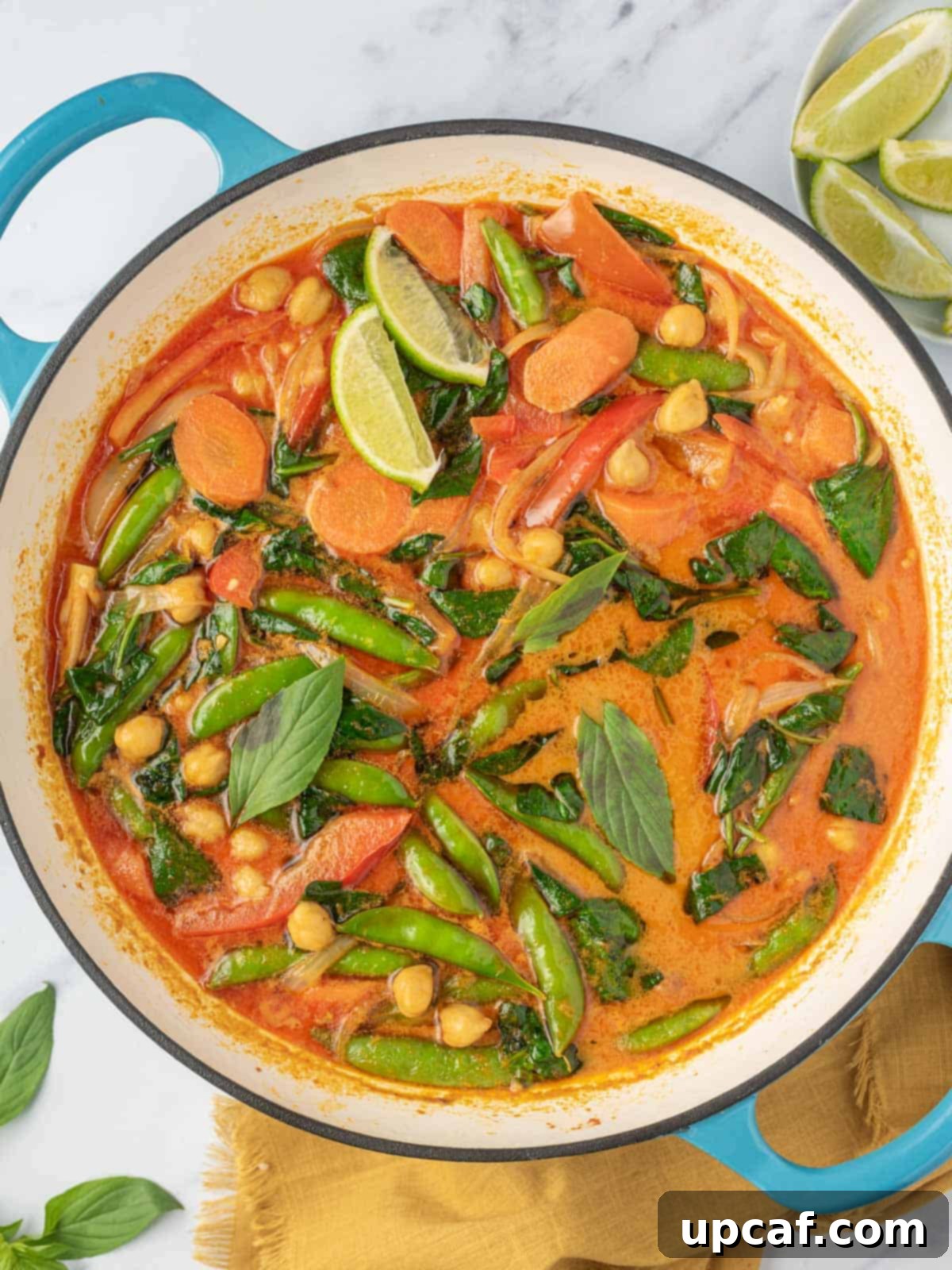
- Step 3: The Perfect Finish – Garnish and Serve. Once your curry has finished its delightful simmering, carefully remove the skillet or Dutch oven from the heat. This is the moment to introduce the final, crucial flavor enhancer: stir in the fresh lime juice. This bright, acidic component is absolutely vital for balancing the inherent richness of the coconut milk and elevating the overall flavor profile of the curry, adding a refreshing zesty zing. Give it a good, final stir to ensure the lime juice is well incorporated. To complete this culinary masterpiece, generously garnish the curry with a scattering of fresh Thai basil leaves. The fragrant basil not only adds a beautiful, contrasting aroma but also provides that final, authentic layer of Thai taste that truly defines the dish. Serve your exquisitely delicious Red Thai Vegan Curry immediately over a fluffy bed of freshly cooked white rice (such as jasmine rice) or your favorite style of silky noodles to fully enjoy its creamy, spicy, and deeply aromatic goodness. Don’t forget to offer extra lime wedges on the side for those who enjoy an additional burst of freshness!

Expert Tips for the Best Vegan Thai Curry with Vegetables
Achieving a restaurant-quality Red Thai Vegan Curry at home is easier than you think when you incorporate these expert tips and tricks into your cooking process. These small adjustments can significantly elevate the flavor, texture, and overall enjoyment of your homemade curry.
- Maximize Flavor with Abundant Aromatics: Never skimp on fresh aromatics such as minced garlic, freshly grated ginger, and thinly sliced onions. These foundational ingredients are the absolute backbone of any truly great curry, providing deep, complex, and savory flavors that elevate the entire dish. Take the time to sauté them properly until they are wonderfully fragrant and softened to release their full aromatic potential. This step is non-negotiable for a rich base.
- Choose Full-Fat Coconut Milk for Ultimate Creaminess: For a truly rich, velvety, and indulgent curry with an authentic mouthfeel, always opt for full-fat canned coconut milk. The higher fat content contributes significantly to the luxurious creamy texture and the robust, traditional flavor of the Thai sauce. While light coconut milk can be used for a lighter version, be aware that it will result in a less robust and creamy curry, altering the overall experience.
- Ensure Even Cooking with Uniform Vegetable Cuts: To guarantee that all your vegetables cook evenly and reach the desired tender-crisp consistency at precisely the same time, make a conscious effort to cut them into roughly the same size and thickness. This attention to detail in your knife work will prevent the frustration of having some vegetables overcooked and mushy while others remain undercooked and raw.
- Embrace Versatility – Swap in Your Favorite Vegetables: This Red Thai Vegan Curry recipe is incredibly adaptable and forgiving. Feel completely free to swap in or add any of your favorite vegetables, or simply utilize what you already have on hand in your refrigerator. Great alternative or additional vegetables include tender broccoli florets, creamy cauliflower, crisp snap peas, fresh green beans, earthy bamboo shoots, crunchy water chestnuts, bell peppers of any vibrant color, or even hearty leafy greens like kale. Remember to adjust cooking times based on the density and firmness of the vegetables you choose.
- Utilize Your Grocery Store’s Salad Bar: If you find yourself short on time for chopping, or if you only need a small quantity of various vegetables for this recipe, your grocery store’s salad bar can be a secret weapon. It’s an excellent and convenient place to quickly gather all the pre-prepped veggies you need with minimal or absolutely no additional chopping required, thereby saving you precious preparation time and making weeknight cooking a breeze.
- Verify Vegan-Friendly Red Curry Paste: It is critically important to be mindful that some brands of commercially available red curry paste traditionally contain shrimp paste (kapi) or fish sauce, which are not vegan ingredients. Always carefully check the ingredients label on the jar to ensure you select a truly plant-based and vegan-certified red curry paste for your dish. Fortunately, many excellent vegan brands are now widely available in most grocery stores and Asian markets.
- Boost Protein with Tofu or Tempeh: For an extra boost of plant-based protein and to make the meal even heartier and more substantial, consider adding baked, pan-fried, or air-fried tofu cubes or tempeh. Pressing the tofu beforehand will significantly help it absorb the rich, aromatic flavors of the curry beautifully. Add them during the last few minutes of simmering, allowing them to heat through and meld with the sauce.
- Adjust the Heat Level to Your Liking: The beauty of homemade curry is the ability to customize its spice level. If you prefer a spicier curry that truly kicks, it’s easy to dial up the heat. You can add a generous pinch of red chili flakes, thinly sliced fresh red chilies (like fiery bird’s eye chilies), or a drizzle of spicy chili oil towards the end of cooking or as an optional garnish. Always start with a small amount and gradually add more until you achieve your perfectly desired level of heat.
- Fresh Herbs and Citrus are Key for the Finish: Never underestimate the transformative power of fresh herbs and citrus right at the end of cooking. A generous scattering of fresh Thai basil leaves and a final squeeze of fresh lime juice right before serving dramatically brighten the overall flavors, cut through the richness, and add that authentic, vibrant Thai finish that makes all the difference. These elements are non-negotiable for a truly complete and balanced taste experience.

Frequently Asked Questions About Vegan Red Thai Curry
Here are some common questions and helpful answers regarding this delicious and authentic Red Thai Vegan Curry, addressing everything from health benefits to storage tips.
Generally, curries, especially those generously packed with a variety of fresh and colorful vegetables, are widely considered a healthy and nutritious meal option. This Red Thai Vegan Curry is a prime example, loaded with nutrient-dense ingredients like carrots, spinach, and bell peppers, all of which provide essential vitamins, minerals, and beneficial dietary fiber. While full-fat coconut milk is calorie-dense due to its healthy medium-chain triglycerides (MCTs), it’s a good source of energy and contributes to satiety. You can certainly lighten the dish slightly by opting for light coconut milk if preferred, although it may result in a less creamy texture and a slightly milder flavor profile. Additionally, controlling your portion of rice (which is naturally high in carbohydrates) or serving the curry with a lighter alternative like cauliflower rice or simply extra steamed vegetables can further enhance its health profile, making it suitable for various dietary needs. This dish is naturally gluten-free if served with rice or certified gluten-free noodles, and provides a good source of plant-based protein from the chickpeas.
Red curry paste is a vibrant, aromatic, and absolutely essential ingredient that forms the heart of many Thai dishes. It is a concentrated, potent mixture typically comprising dried red chilies, aromatic lemongrass, pungent galangal (a type of Thai ginger), fresh kaffir lime zest, garlic, shallots, and a blend of various other traditional Thai spices. The flavor profile is usually characterized by its mild to moderately spicy heat, coupled with a complex blend of citrusy, earthy, and distinctly pungent notes. It is utterly crucial for achieving the authentic, deep, and savory taste of traditional Thai red curry. When you are preparing a vegan dish, it is paramount to remember to carefully read the label on any red curry paste you purchase, as some brands traditionally include shrimp paste (kapi) or fish sauce, which are animal-derived ingredients. Fortunately, due to increasing demand, many excellent vegan-friendly red curry pastes are now widely available in most grocery stores or Asian markets, ensuring your homemade curry remains entirely plant-based and delicious.
The primary distinction between yellow, red, and green Thai curry pastes largely stems from the types and quantities of chilies used in their preparation, which directly dictates their characteristic color, general flavor profile, and typical heat level.
- Green Curry Paste: This paste is typically made with fresh green chilies, which give it its vibrant, signature green color. It is often considered the spiciest of the three, boasting a fresh, bright, and intensely herbaceous flavor profile due to the inclusion of fresh ingredients like vibrant green chilies, fresh basil, and aromatic kaffir lime leaves.
- Red Curry Paste: As featured in this recipe, red curry paste is made primarily with dried red chilies, which contribute to its distinctive reddish-orange hue. It usually falls in the middle of the spice spectrum – offering a satisfying, moderately spicy kick – and provides a rich, deep, and more savory flavor compared to green curry, often with discernible notes of earthy cumin and fragrant coriander.
- Yellow Curry Paste: This paste often incorporates a significant amount of turmeric, which imparts its characteristic bright yellow color. Yellow curry is generally considered the mildest of the three main Thai curry pastes. It tends to be sweeter and creamier, with a flavor profile often influenced by a blend of dried Indian spices such as turmeric, yellow curry powder, and cardamom, giving it a somewhat Indian-Thai fusion taste that is both comforting and aromatic.
Beyond the chilies, the specific blend of other aromatics and spices can vary significantly between different brands and regional Thai cooking traditions, leading to unique nuances in flavor and heat. Experimenting with various brands and colors is a delightful way to discover your personal favorite and expand your culinary horizons!
One of the truly wonderful qualities of homemade curry is that its complex flavors often deepen and become even more harmonious and full-bodied the day after it’s cooked, making leftovers an highly anticipated treat. To properly store your delicious Red Thai Vegan Curry, first allow it to cool completely to room temperature. Once cooled, transfer it into an airtight container. It can then be safely stored in the refrigerator for up to 5 days, maintaining its exquisite taste and texture. When you’re ready to indulge in it again, simply reheat individual portions gently in the microwave until thoroughly warm, or for a stovetop method, warm it carefully in a skillet over medium-high heat, stirring occasionally to prevent any sticking. If the sauce has thickened too much during storage, a small splash of water or vegetable broth can be added to achieve your desired consistency.
Absolutely! This Vegan Red Curry freezes beautifully, making it an excellent and convenient option for long-term meal planning and for having quick, healthy meals on standby. Once the curry has completely cooled to room temperature, transfer it into a freezer-safe container or a heavy-duty freezer bag, ensuring to leave a little headspace at the top for expansion during freezing. It can be safely stored in the freezer for up to 3 months without any significant loss of quality, flavor, or texture. To enjoy your frozen curry, simply defrost it overnight in the refrigerator. Once fully thawed, reheat it gently in the microwave until heated through, or warm it in a skillet over medium-high heat on the stovetop, stirring occasionally until piping hot. Freezing is a fantastic way to ensure you always have a homemade, delicious, and wholesome meal ready whenever you need it most.
The rich, creamy, and spicy sauce of authentic Thai Red Curry is incredibly versatile and perfect for pairing with a variety of accompaniments that help soak up every last drop of its deliciousness.
- Rice: The most classic and traditional pairing is fluffy white rice, such as aromatic jasmine rice, which perfectly complements the curry’s bold flavors and creamy texture. For a healthier or lower-carb option, consider serving it with our recipe for cauliflower rice.
- Noodles: Thai curries are also wonderfully excellent when served with various types of noodles. Delicate rice noodles (like thin vermicelli or wider flat rice noodles), or even whole wheat noodles, can provide a satisfying and delightful alternative to rice.
- Bread: Warm, soft naan bread or any other type of flatbread is fantastic for dipping into the luscious sauce, offering a delightful textural contrast and ensuring no drop of the flavorful curry goes to waste.
- Quinoa or Other Grains: For a nutrient-dense and gluten-free option, serve your Red Thai Vegan Curry over cooked quinoa, couscous, or other wholesome whole grains to create a more robust and filling meal.
- Additional Sides: To round out the meal beautifully and add extra freshness, consider serving a simple side salad with a light vinaigrette or some lightly steamed green vegetables like bok choy or broccoli on the side.
Is This Vegan Red Curry Gluten-Free?
Yes, this Red Thai Vegan Curry recipe is inherently gluten-free, provided you make careful and informed ingredient selections. The vast majority of the ingredients used—fresh vegetables, rich coconut milk, and standard spices—are naturally free of gluten. The critical component that requires attention and verification is the red curry paste, as some brands available on the market may unfortunately contain wheat, soy sauce, or other gluten-containing additives as binders or flavor enhancers. Therefore, always ensure you purchase a brand that is specifically labeled and certified as gluten-free. Additionally, if you choose to serve your curry with noodles, it is imperative to opt for rice noodles or other certified gluten-free noodle varieties to maintain its gluten-free status. When paired with fragrant jasmine rice and a verified gluten-free curry paste, this meal is a truly wonderful, safe, and delicious option for individuals with gluten sensitivities or those diagnosed with celiac disease.
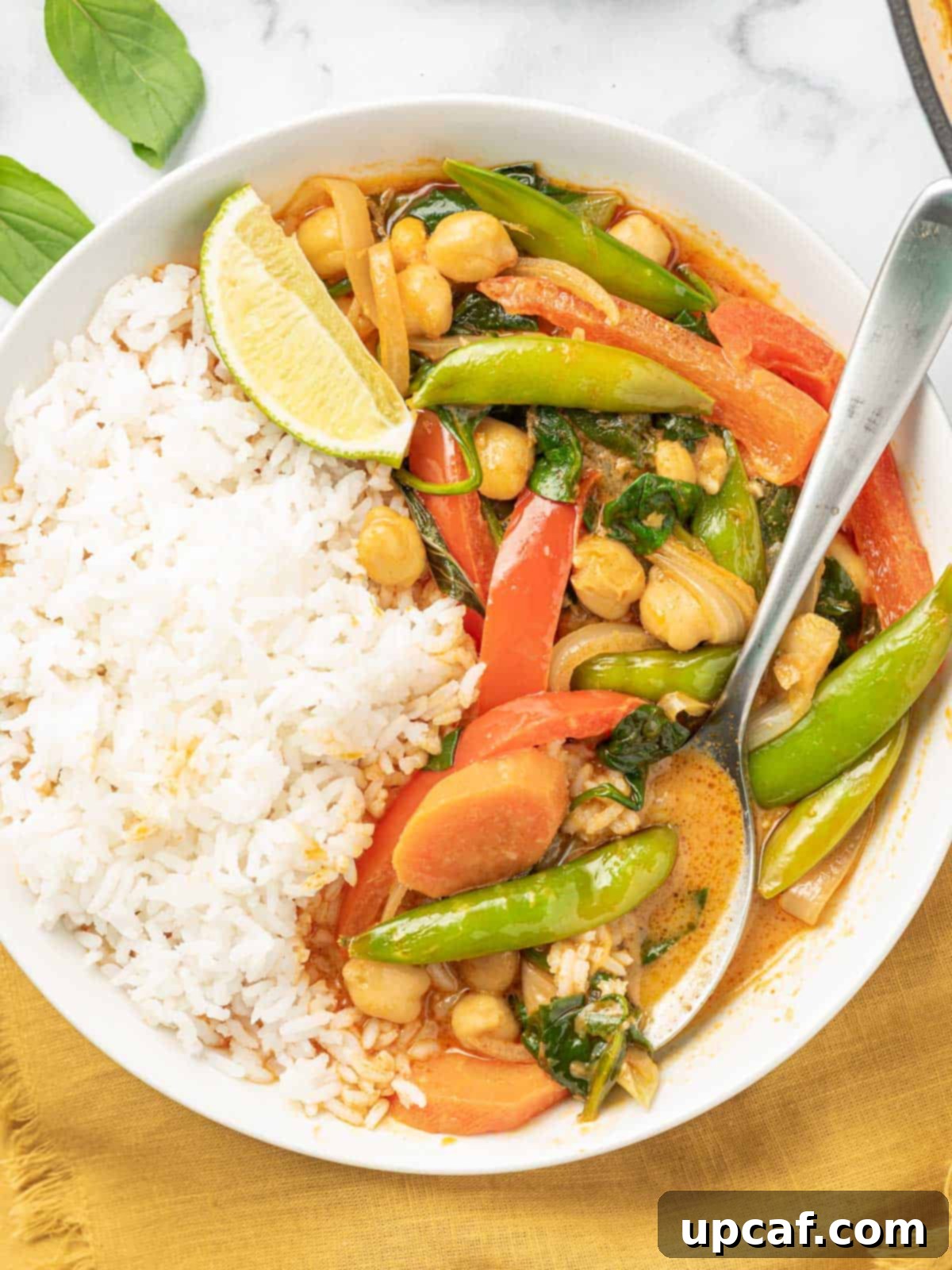
Explore More Delicious Vegetable-Loaded Recipes for Healthy Eating
If you’ve thoroughly enjoyed the wholesome goodness, vibrant flavors, and plant-based satisfaction of this Red Thai Vegan Curry, you’re in for an absolute treat! We are passionate about celebrating the incredible versatility of vegetables and creating meals that are not only deeply nourishing but also incredibly satisfying and bursting with flavor. Here are more of our cherished recipes that pack a powerful punch with fresh, wholesome produce:
- Hearty Homemade Vegetable Soup: A timeless classic, perfect for a comforting, soul-warming, and highly nutritious meal that’s versatile and easy to customize.
- Quick Air Fryer Shrimp and Vegetables: A fast, convenient, and flavorful option for a balanced, protein-packed meal that comes together with minimal effort.
- One-Pan Skillet Salmon with Vegetables: Simple to prepare, elegantly presented, and packed with heart-healthy omega-3 fats alongside a colorful array of fresh, tender-crisp vegetables.
- Easy Vegan Lentil Chili: A robust, hearty, and incredibly filling plant-based chili that’s perfect for chilly evenings, offering a wealth of fiber and protein.
We genuinely hope you enjoy exploring all the delicious recipes we share with you, including this incredibly vibrant, comforting, and authentic Red Thai Vegan Curry recipe. Your feedback is truly invaluable to us, and we enthusiastically encourage you to try it in your kitchen, savor every delectable bite, rate it based on your experience, and generously share this delightful recipe with your cherished friends and family!
If you try this recipe and absolutely loved it, please take a moment to leave a star rating and share your wonderful comments below. Your feedback helps us grow and inspires other home cooks! Don’t forget to use our unique hashtag to share your delicious recreations with us on Instagram so we can see and celebrate your culinary successes! Also, for all our latest social posts, culinary inspiration, exclusive tips, and exciting new recipes, be sure to follow Cookin’ With Mima on FACEBOOK | INSTAGRAM | PINTEREST. Happy cooking!
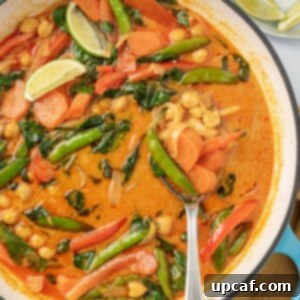
Print Recipe
Red Thai Vegan Curry
This Red Thai Vegan Curry is a creamy, warm, and comforting dish, authentically inspired by the rich and complex flavors of traditional Thai red curry. Packed with a vibrant assortment of fresh vegetables, this customizable recipe comes together quickly in just 35 minutes and is perfectly served over fluffy rice or silky noodles.
Ingredients
- 2 tablespoons coconut oil
- 1 teaspoon garlic, minced
- 1 teaspoon ginger, grated
- 1 small yellow onion, thinly sliced
- 1 medium red bell pepper, thinly sliced
- 2 medium carrots, thickly sliced
- 3 tablespoons red curry paste (ensure vegan-friendly)
- 1 (15 oz.) can full-fat coconut milk
- 1 teaspoon salt
- 1 cup canned chickpeas, rinsed and drained
- 25-30 pieces fresh snow peas
- 2 cups fresh spinach
- ½ fresh lime juice (from about 1 lime)
- Fresh Thai basil, to garnish
- Lime wedges, to serve
Instructions
- Heat 2 tablespoons of coconut oil over medium heat in a large skillet or Dutch oven. Add minced garlic, grated ginger, and thinly sliced onion. Sauté for 2-3 minutes until fragrant and the onion softens.
- Add the red bell pepper and carrots and continue to sauté for 3-4 minutes. Stir in the red curry paste and cook for one minute, stirring constantly, to allow its flavors to bloom.
- Pour in the canned coconut milk and add salt. Bring the mixture to a gentle boil, then reduce heat to medium. Add the chickpeas and snow peas and simmer for 5-6 minutes.
- Stir in the fresh spinach and continue to simmer for 2 more minutes, or until the spinach is fully wilted into the sauce.
- Remove the skillet from the heat. Stir in the fresh lime juice and generously garnish the curry with fresh Thai basil leaves.
- Serve your delicious Red Thai Vegan Curry immediately with white rice, jasmine rice, or noodles, accompanied by extra lime wedges if desired.
Notes
- Do not skimp on fresh aromatics like garlic, ginger, and onions; they are crucial for depth of flavor.
- Using full-fat coconut milk will ensure a rich, creamy, and truly delicious curry.
- Cut your vegetables to similar sizes to promote even cooking throughout the dish.
- This recipe is highly customizable; feel free to swap in your favorite vegetables or utilize what you have on hand.
- Always check the label of your red curry paste to ensure it is truly vegan and does not contain shrimp paste.
- For an added protein boost, consider stirring in baked, pan-fried, or air-fried tofu or tempeh cubes.
- Adjust the spice level to your preference by adding red chili flakes, thinly sliced fresh red chilies, or a drizzle of chili oil.
Nutrition Information (per serving, approximate)
- Calories: 148 kcal
- Carbohydrates: 16 g
- Protein: 4 g
- Fat: 9 g
- Saturated Fat: 6 g
- Polyunsaturated Fat: 1 g
- Monounsaturated Fat: 1 g
- Sodium: 731 mg
- Potassium: 366 mg
- Fiber: 5 g
- Sugar: 5 g
- Vitamin A: 9282 IU
- Vitamin C: 52 mg
- Calcium: 69 mg
- Iron: 2 mg
Enjoyed this recipe? Please rate and leave a comment below!
We appreciate your feedback and love seeing your culinary creations.
